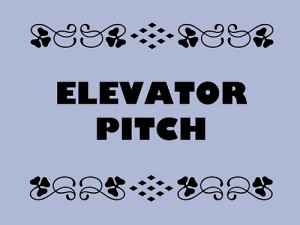As entrepreneurs, we are always fine tuning the answer to the question, “What do you do?” There are so many ways to answer this question including many different techniques, formulas and rules of thumb. Personally I have tried various different answers over the years, some really good and some not so good. Through experience, I’ve learned that the best way to describe what I do is to tackle my elevator pitch using two different, yet somewhat similar approaches. If you are faced with the challenge of not knowing just how to describe your products or services in a compelling way, allow me to offer you two simple ways to approach your elevator pitch.
#1 – THE SOLUTIONS BASED APPROACH
The first approach is what I call the “basic-problems-most-people-encounter” approach.
Before I go into specifics about this approach, let me caution you about its use. When you use an elevator pitch, realize that it works best if you are targeting it to a specific group of people; your niche. For the basis of this example, “people” will serve as the target but understand you have to get much more specific for the purpose of pitching your services. The B-P-P-E approach is the one I use in casual situations or informal networking settings. Here’s the formula. “Ever noticed how most (insert people) usually encounter (insert problem)? Well, I help them to address that issue by offering them (insert solution).” The B-P-P-E approach allows me to paint a picture of a common problem held by people in my niche that I offer a solution for. By beginning the pitch with the problem, I am demonstrating that I have expertise in this area and positioning myself as the “go-to” problem solver. This approach is particularly effective if the person you are speaking to can relate to the problem you are describing and are intrigued by the solution you provide. Therefore if you communicate that you have the perfect solution for a specific problem held by specific group of people, you’ve just become the person with a memorable and compelling elevator pitch. On the contrary, if you are unclear about the people you are able to help, and too generic about the solution you offer, you have just become the confusing person who is easy to forget.
If you were my client, I would advise you to get as specific as possible when identifying your ideal clients: the people who need your solution most and closely fit your ideal profile or target group best. If you work really hard to think of a compelling challenge or problem that your target group deals with on a regular basis, that you have a solution for, you will hit a home run every time.
#2 THE EXPERTISE BASED APPROACH
The second approach is what I call the “expertise-goals-problems” approach.
Again, allow me to caution you about the usage of this approach. If you are going to speak in general terms with your target audience, you must use general terms throughout the pitch including general terms to describe your solution. It will not make sense to define a broad group of people as your target group and then offer a narrowly defined solution for them or vice verse.
The basis of the E-G-P approach is to begin with your area of expertise and then add a common goal shared by most people in your target group or niche, then end with a common problem that all of these people want to avoid. Here’s the formula. “I specialize in working with (insert people) helping them (insert goal) and thereby avoid (insert problem).” With this approach you have successfully included your area of specialty and expertise, stated who your ideal clients are, the goals they typically have and finally the common problems they are trying to avoid. This approach allows you to lead with your skills, specialty and expertise. Remember, summarizing what you do in a way that makes people interested to learn more or curious to hear you explain further, is the ultimate goal.
If you’ve been in business for awhile, you undoubtedly have an elevator pitch already. The question is this: “how well does it work for you?” If your elevator pitch is not paying off in the form of helping you to convert prospects into paying clients, you need to revisit how you describe what you do.
When you begin to describe what you do, you have to get comfortable letting it roll off of your tongue. If you are not comfortable with your elevator pitch, it will show. The key is to be very confident in the way you deliver your message.
Through trial and error, I have learned a few strategies that work best when it comes to pitching my services. It took me months of practice learning how to deliver my elevator pitch effectively so I could attract the RIGHT people. You will notice that as you try different versions of your elevator pitch, you will find what approach works best for you. I’ve noticed that when I insist that my clients practice their elevator pitch in the mirror, they get more confident in saying what it is that they do and how they do it. As the old saying goes, practice makes perfect.
NOW IT’S YOUR TURN.
Leave a comment below and tell me how you approach your elevator pitch. Do you say the same thing every time or do you switch it up? Remember consistency is key.
© 2012 Quality Media Consultant Group, LLC – All Rights Reserved
This article is written by Lori A. Manns. Want to use this article for your website, blog or newsletter? No problem. Here’s what you must include: Lori A. Manns, CEO of Quality Media Consultant Group, and a trailblazing business strategist. Lori is the creator of the Sponsorship Sales Secrets System;TM that shows you how to get more sponsors and grow your business. Learn proven sales strategies to help you grow your revenue, guaranteed. To learn more about how you can work with Lori to grow your revenue, join her newsletter list and get a free gift, please visit www.qualitymediaconsultants.com.


Thank you for explaining the two different approaches to the elevator speech problem. It makes it very clear as to what to include and present one’s expertise when using each approach.
This was good, Lori! I still hate elevator pitches. LOL I went to this chamber event a week ago and people were pitching me and I didn’t even ask them what they did. It was scary!